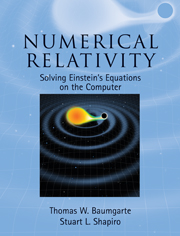Book contents
- Frontmatter
- Contents
- Preface
- Suggestions for using this book
- 1 General relativity preliminaries
- 2 The 3 + 1 decompostion of Einstein's equations
- 3 Constructing initial data
- 4 Choosing coordinates: the lapse and shift
- 5 Matter sources
- 6 Numerical methods
- 7 Locating black hole horizons
- 8 Spherically symmetric spacetimes
- 9 Gravitational waves
- 10 Collapse of collisionless clusters in axisymmetry
- 11 Recasting the evolution equations
- 12 Binary black hole initial data
- 13 Binary black hole evolution
- 14 Rotating stars
- 15 Binary neutron star initial data
- 16 Binary neutron star evolution
- 17 Binary black hole–neutron stars: initial data and evolution
- 18 Epilogue
- A Lie derivatives, Killing vectors, and tensor densities
- B Solving the vector Laplacian
- C The surface element on the apparent horizon
- D Scalar, vector and tensor spherical harmonics
- E Post-Newtonian results
- F Collisionless matter evolution in axisymmetry: basic equations
- G Rotating equilibria: gravitational field equations
- H Moving puncture representions of Schwarzschild: analytical results
- I Binary black hole puncture simulations as test problems
- References
- Index
4 - Choosing coordinates: the lapse and shift
Published online by Cambridge University Press: 05 March 2013
- Frontmatter
- Contents
- Preface
- Suggestions for using this book
- 1 General relativity preliminaries
- 2 The 3 + 1 decompostion of Einstein's equations
- 3 Constructing initial data
- 4 Choosing coordinates: the lapse and shift
- 5 Matter sources
- 6 Numerical methods
- 7 Locating black hole horizons
- 8 Spherically symmetric spacetimes
- 9 Gravitational waves
- 10 Collapse of collisionless clusters in axisymmetry
- 11 Recasting the evolution equations
- 12 Binary black hole initial data
- 13 Binary black hole evolution
- 14 Rotating stars
- 15 Binary neutron star initial data
- 16 Binary neutron star evolution
- 17 Binary black hole–neutron stars: initial data and evolution
- 18 Epilogue
- A Lie derivatives, Killing vectors, and tensor densities
- B Solving the vector Laplacian
- C The surface element on the apparent horizon
- D Scalar, vector and tensor spherical harmonics
- E Post-Newtonian results
- F Collisionless matter evolution in axisymmetry: basic equations
- G Rotating equilibria: gravitational field equations
- H Moving puncture representions of Schwarzschild: analytical results
- I Binary black hole puncture simulations as test problems
- References
- Index
Summary
In Chapter 2 we performed a 3 + 1 decomposition of Einstein's field equations and have seen that these can be split into two distinct sets: constraint equations and evolution equations. The constraint equations contain no time derivatives and relate field quantities on a given t = constant spacelike hypersurface. The evolution equations contain first-order time derivatives that tell us how the field quantities change from one hypersurface to the next. In Chapter 3 we have brought the constraint equations into a form that is suitable for numerical implementation, that is, we cast the equations in terms of spatial differential operators that can be inverted with standard numerical techniques. We will provide a brief introduction to some common numerical algorithms for solving these (elliptic) equations in Chapter 6. The 3 + 1 evolution equations that we derived, e.g., equation (2.134) for γij, and equation (2.135) for Kij, are not quite ready for numerical integration. For one thing, we have yet to impose coordinate conditions by specifying the lapse function α and the shift vector βithat appear in these equations. The lapse and shift are freely specifiable gauge variables that need to be chosen in order to advance the field data from one time slice to the next. As it turns out, finding kinematical conditions for the coordinates that allow for a well-behaved, long time evolution is nontrivial in general. However, geometric insight and numerical experimentation can be combined to produce good gauge choices for treating many of the most important physical and astrophysical problems requiring numerical relativity for solution, as we shall see.
- Type
- Chapter
- Information
- Numerical RelativitySolving Einstein's Equations on the Computer, pp. 98 - 122Publisher: Cambridge University PressPrint publication year: 2010



